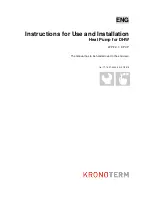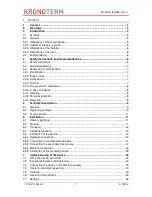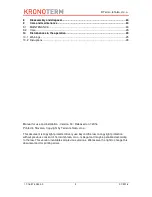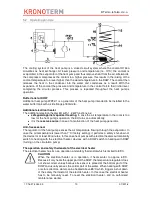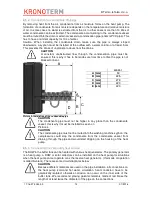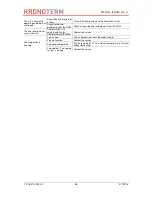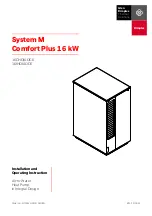
© Termo-tehnika, d.o.o.
17-16-27-3033-00
14
07/2016
6.5.2 Connection for condensate drainage
By removing heat from the air, condensate from air moisture forms on the heat pump. The
formation of condensate from air moisture depends on the temperature and relative moisture
of air. In some cases no water is extracted from the air, in other cases more than 10 litres of
water condensate can be extracted. The condensate accumulating in the condensate vessel
must be routed into the drain or external vessel via condensation pipe (
φ
16mm PVC pipe). This
has to have a minimal capacity for 10 L of water.
Caution: When installing the condensate drain, make sure the pipe is always sloped
downwards, a syphon must be installed at the outflow with a water column of at least 5 cm.
This prevents the intake of unpleasant odours from the drains.
CAUTION
A constant unobstructed flow through the condensation pipe must be
ensured, this is why it has to be made sure from time to time the pipe is not
blocked or bent.
Picture 4: Installation of the condensate pipe
CAUTION
The condensate pipe must not be higher in any place than the condensate
vessel; this is why it must be installed as seen on
Picture
4
.
CAUTION
The condensate pipe must not be routed into the washing machine syphon; the
overpressure could stop the condensate from the condensate vessel from
draining through the pipe and would start dripping on the housing of the heat
pump.
6.5.3 Connecting the secondary heat source
The DHW in the buffer tank can be heated with various heat generators. The primary generator
is a heat pump; a DHW or solar collectors can be installed on the heat pump for situations
when the heat pump cannot operate or as the reserve heat generator - (this mode of operation
is called bivalent). There are some circuit diagrams below.
CAUTION
Because different materials are used on the pipe installation, all connections on
the heat pump (cold and hot water, circulation, heat conductor) have to be
galvanically isolated; otherwise corrosion can occur on the inner side of the
buffer tank. We recommend placing galvanic isolators made of red brass the
length of at least twice the diameter of the pipe on the connections.
WP-F2-1
A [mm]
50
B [mm]
225
C [mm]
273
D [mm]
220
E [mm]
420
A
A
B
D
C

